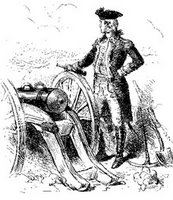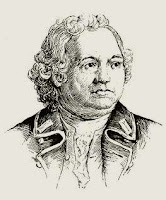
I seem to be on a roll with
Henry Knox, so I might as well continue.
A while back, I laid out my argument that Knox’s 1774 marriage into the family of
Thomas Flucker, royal Secretary of the province of Massachusetts, prompted some people to assume he’d favor the Crown like his father-in-law.
Knox’s name doesn’t appear on the lists of Whig activists from before the war. His most prominent public activities—testifying about the
Boston Massacre and helping to found a
militia grenadier company—give no good clues about his leanings in the context of the town. We have few papers from Knox before his marriage, and their few political comments are middle-of-the-road for a Boston businessman.
So authors filled the vacuum. Margherita Arlina Hamm’s
Builders of the Republic, published in 1902, states:
Governor [Thomas] Gage had started a system of espionage and surveillance upon all suspected rebels, in which category was the young bookseller. . . . with a group of patriots [he] established a counter espionage upon the officials and their spies. With him in this work was his friend Paul Revere the engraver.
At the time Revere was not suspected, and on account of his business relations with Knox could come and go from the latter’s store without arousing suspicion. He took the precaution however, always to bring a plate when he visited the bookseller, and if there were any spies or British officers about, to have a make-believe quarrel in regard to imaginary work. Time and again when they had the wrong kind of an audience, he would denounce Knox at the top of his lungs, and Knox would give as good as he received, until they were alone. They carried out this comedy so successfully that on several occasions Revere was asked by British spies for information respecting the rebel bookseller.
Unfortunately, Hamm’s book didn’t include any citations at all. There’s no equivalent for this story in Noah Brooks’s biography of Knox, published two years earlier, or Elbridge H. Goss’s biography of Revere, published in 1891. Nor is there any contemporaneous document to support Hamm’s statement that the royal authorities were watching Knox or sought information about him from Revere.
In fact, Revere advertised his print of the Massacre in 1770, one of many harsh Whig political cartoons he engraved and sold. In 1771, newspapers reported, he hosted a commemoration of the Massacre at his house.
John Adams’s diary shows that Revere attended political organizing meetings at the
Boston Gazette office. The records of the North End Caucus show he was active in that political organization.
In November 1773 Revere was second man in line to volunteer to
patrol the docks and ensure nobody unloaded the
tea ships. In September 1774 he carried the Suffolk Resolves to the First
Continental Congress in Philadelphia. All told, it’s very hard to imagine that “Revere was not suspected” of being a radical Whig. In fact, he should have been high on the royal authorities’ list.
Furthermore, in 1798 Revere wrote a detailed account of his intelligence and counterintelligence activity before the war, and it didn’t mention Knox. (I contend Revere hid
Knox’s help in November 1774—help that was possible only if Knox still had his father-in-law’s confidence.)
Hamm’s anecdote fits the common picture of Knox as a stalwart Whig well before the war. It has the “fool the silly British officers” structure that American have long loved. It continues to appear in Knox biographies, including those by North Callahan and Mark Puls (neither of whom cites Hamm specifically). But there’s no reason to believe it.
 On 4 and 11 August, the city of Cambridge will once again celebrate Cambridge Discovery Days with free walking tours, house tours, and other events at historic sites. This year’s theme is “Power and Politics,” inspired by the centennial of Cambridge’s own Tip O’Neill.
On 4 and 11 August, the city of Cambridge will once again celebrate Cambridge Discovery Days with free walking tours, house tours, and other events at historic sites. This year’s theme is “Power and Politics,” inspired by the centennial of Cambridge’s own Tip O’Neill.




